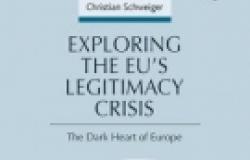Book Review - Exploring the EU’s Legitimacy Crisis: The Dark Heart of Europe

Exploring the EU’s Legitimacy Crisis: The Dark Heart of Europe by Christian Schweiger. Cheltenham: Edward Elgar (New Horizons in European Politics series) 2016. 296 pp, £85 hardcover 978-1-78471-784-1, £30 e-book 978-1-78471-785-8
In 2017 the EU breathed a sigh of relief that the threat from populist parties which, amongst other things, aim for the disintegration of the European Union, did not fully materialise. Much of the recent support for Europe’s new wave of populism stems from the economic fallout of the 2007/08 banking crisis, which spilt over into the Eurozone crisis and was met with EU-driven austerity, with massive cuts to public spending and an increase in unemployment. However, those who feel that the worst of this is now over should read Schweiger’s book – Exploring the EU’s Legitimacy Crisis: The Dark Heart of Europe. While unemployment is slowly falling and economic growth is on the up, any subsequent decline in support for populism should be treated with caution, particularly given that support for the EU had been on a long-downward trend over the two decades prior to the crisis. In short, there is something inherently wrong with the European Integration project and Schweiger sets himself the challenge to explore this issue. Schweiger guides the reader through a forensic analysis of when the EU’s legitimacy crisis began, the various reasons as to why it has occurred, including decisions that have been taken since the advent of the crisis, and importantly, what can be done about. For the author, the EU’s problems began following the Treaty changes at Maastricht (1992), which instilled a contradiction into the European integration project of expanding supranational Community law without addressing the EU’s democratic deficit (Chapter 2). Meanwhile, in Chapter 3 it is argued that the engine of European integration – the Franco-German relationship – has faltered, not least because in an EU of 28 (soon to be 27), the domination of the integration process by two member states is near impossible (and undesirable). The problem, though, is that the variable geometry that has replaced it, of shifting member state coalitions in the European Council to drive integration forward, has been only partially successful in replacing the void left by the weakening of the Franco-German partnership.
Schweiger guides the reader through a forensic analysis of when the EU’s legitimacy crisis began, the various reasons as to why it has occurred, including decisions that have been taken since the advent of the crisis, and importantly, what can be done about. For the author, the EU’s problems began following the Treaty changes at Maastricht (1992), which instilled a contradiction into the European integration project of expanding supranational Community law without addressing the EU’s democratic deficit (Chapter 2). Meanwhile, in Chapter 3 it is argued that the engine of European integration – the Franco-German relationship – has faltered, not least because in an EU of 28 (soon to be 27), the domination of the integration process by two member states is near impossible (and undesirable). The problem, though, is that the variable geometry that has replaced it, of shifting member state coalitions in the European Council to drive integration forward, has been only partially successful in replacing the void left by the weakening of the Franco-German partnership.
Chapters 4 – 7 focus on the recent developments in the process of European integration since the crisis and outline the various dimensions in which the EU has a legitimacy problem. Chapter 4 focuses on the EU’s response to the financial crisis and the new wave of EU governance that continues to lack accountability and transparency. Chapter 5 looks more broadly at the relationship between economic integration and EU social and employment policy. A problem here is that there remains an unresolved tension within the integration project between the narrow economic objectives of the Single Market and the Eurozone with its emphasis on economic stability, and that of economic integration complemented by a European social dimension that serves to counterbalance pure market-driven integration. If continued, this asymmetry within the EU, that favours the former over the latter, is further likely to witness a decline in support for the EU. Chapter 6 analyses the implementation of the Lisbon Treaty reforms, most notably the ability of the European Parliament to nominate the President of the European Commission. Schweiger argues that Spitzenkandidaten system has had some success: but much more is needed to be done to improve democracy and legitimacy in the EU. Finally, Chapter 7 discusses the EU’s failures regarding external relations and neighbourhood policy. For the author, the EU has proved itself incapable in dealing with challenges on its doorstep and is persistently undermined by the unwillingness of member states to concede sovereignty in key strategic policy areas which are essential to maintain security. Here the EU faces a significant challenge as muddling through is likely to produce poor policy responses – yet more decisive EU action will reduce the autonomy of the member states. In short, the broad overview of the EU found in the various chapters makes for pessimistic reading: but Schweiger is spot-on in how he analyses the issues.
The concluding chapter discusses some possible solutions to resolve the EU’s seemingly impossible situation. The conclusion could have been bolder, but given that the book provides the reader with much excellent empirical analysis and so much to think about, this is a small matter. The book is useful either in its entirety for postgraduate students or as individual chapters around the selected themes for third-year undergraduates. For the latter, Chapters 2 (After Maastricht) and 6 (The 2014 European Parliament Elections) particularly stand out. And while the European integration project keeps rumbling on, I want Schweiger to continue writing about it.
Dr Paul Copeland is Senior Lecturer in Public Policy at the School of Politics and International Relations, Queen Mary University of London.

